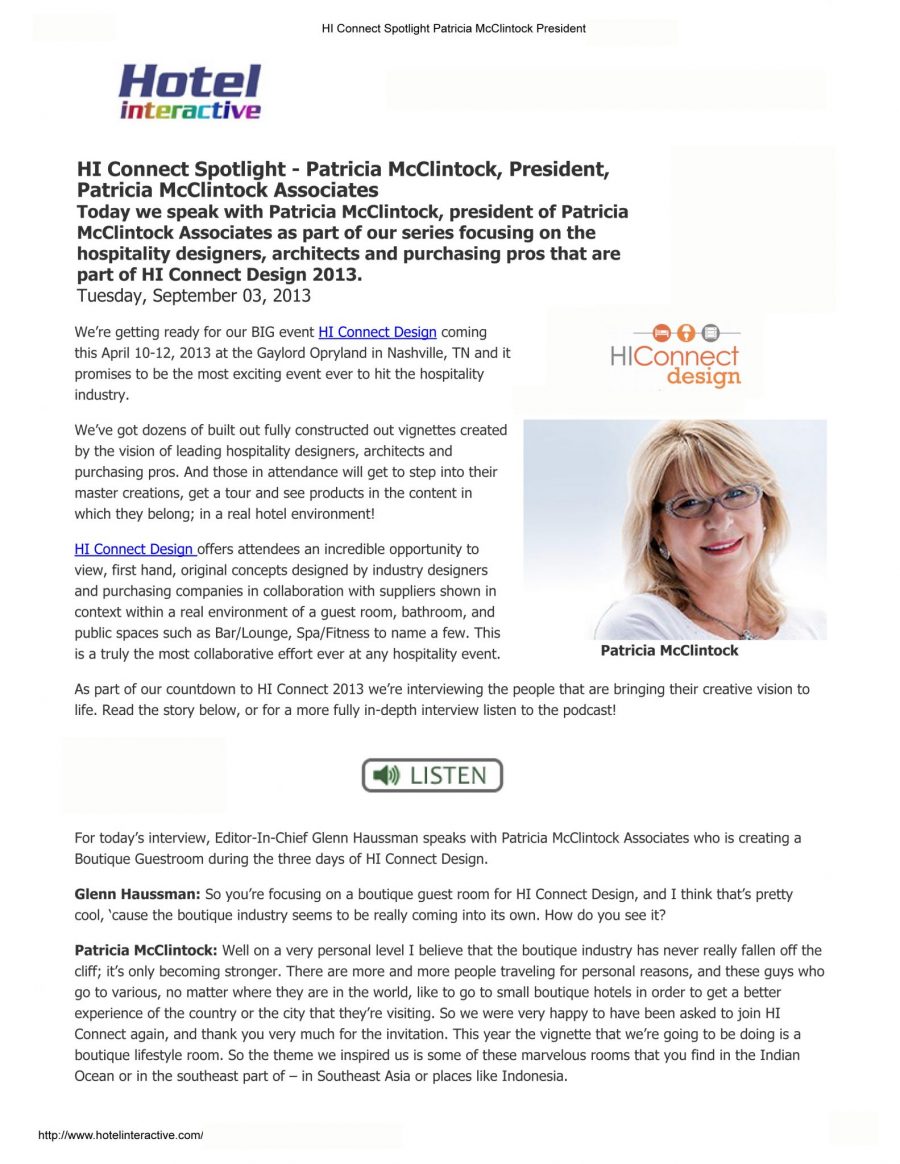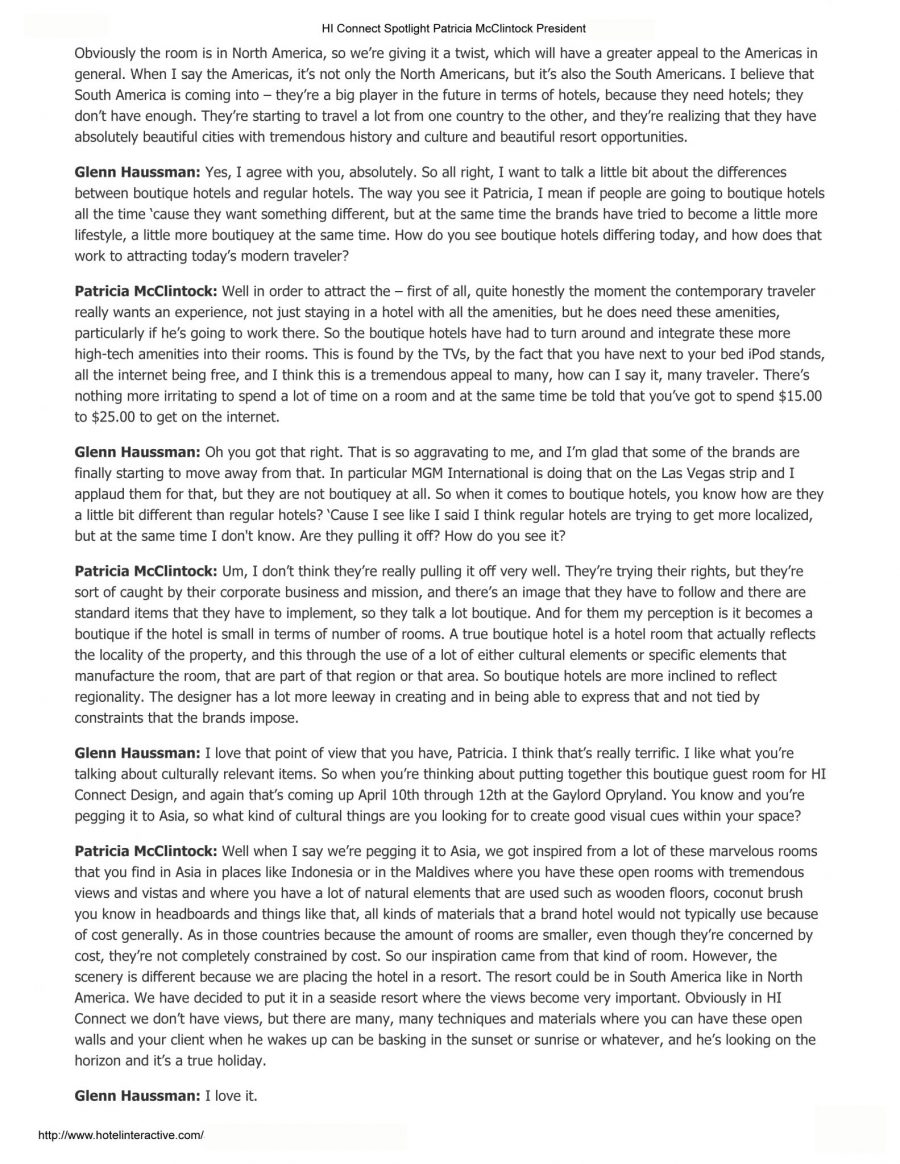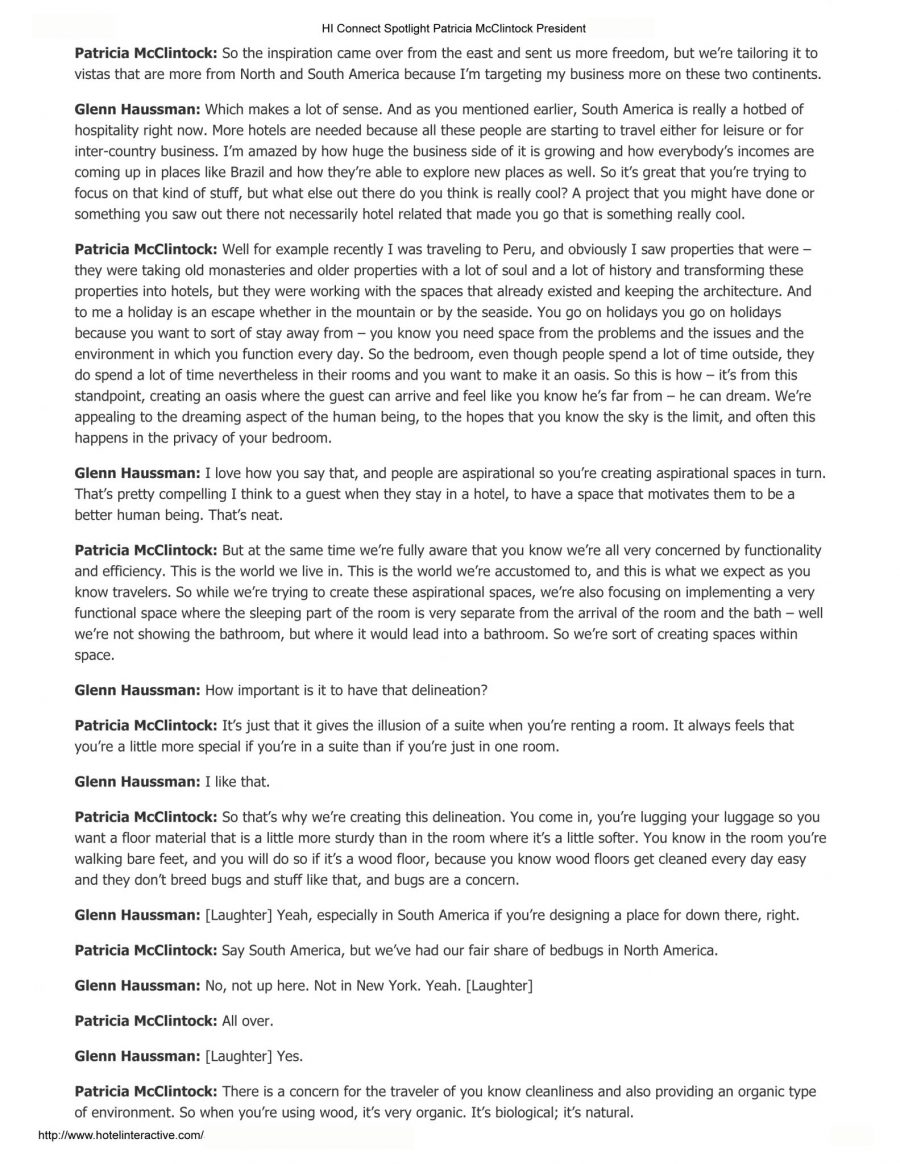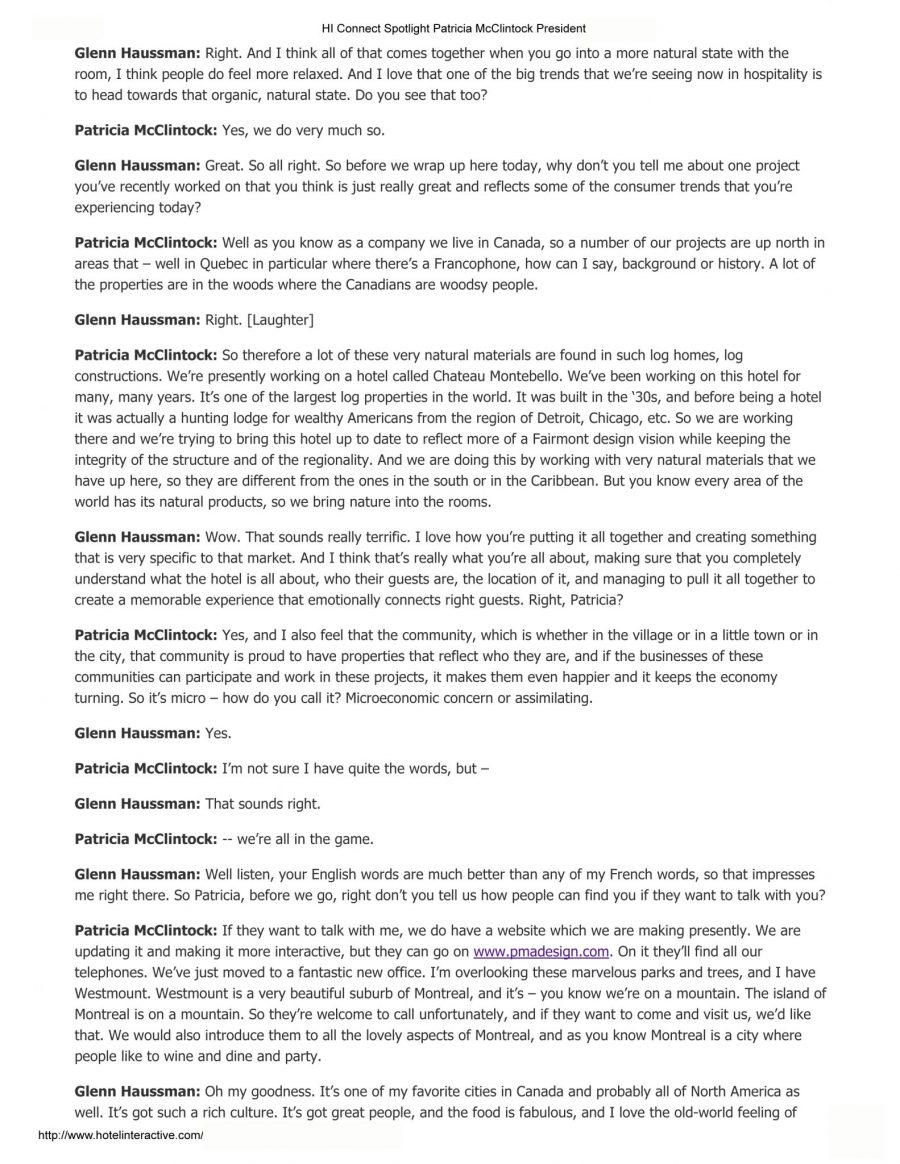
Hi Connect Spotlight with Patricia McClintock
Today we speak with Patricia McClintock, president of Patricia McClintock Associates as part of our series focusing on the hospitality designers, architects and purchasing pros that are part of Hi Connect Design 2013.
By Glenn Haussman
We’re getting ready for our BIG event Hi Connect Design coming this April 10-12, 2013 at the Gaylord Opryland in Nashville, TN and it promises to be the most exciting event ever to hit the hospitality industry.
We’ve got dozens of built out fully constructed out vignettes created by the vision of leading hospitality designers, architects and purchasing pros. And those in attendance will get to step into their master creations, get a tour and see products in the content in which they belong; in a real hotel environment!
Hi Connect Design offers attendees an incredible opportunity to view, first hand, original concepts designed by industry designers and purchasing companies in collaboration with suppliers shown in context within a real environment of a guest room, bathroom, and public spaces such as Bar/Lounge, Spa/Fitness to name a few. This is a truly the most collaborative effort ever at any hospitality event.
As part of our countdown to Hi Connect 2013 we’re interviewing the people that are bringing their creative vision to life. Read the story below, or for a more fully in-depth interview listen to the podcast!
For today’s interview, Editor-In-Chief Glenn Haussman speaks with Patricia McClintock Associates who is creating a Boutique Guestroom during the three days of HI Connect® Design.
Glenn Haussman: So you’re focusing on a boutique guest room for HI Connect® Design, and I think that’s pretty cool, ‘cause the boutique industry seems to be really coming into its own. How do you see it?
Patricia McClintock: Well on a very personal level I believe that the boutique industry has never really fallen off the cliff; it’s only becoming stronger. There are more and more people traveling for personal reasons, and these guys who go to various, no matter where they are in the world, like to go to small boutique hotels in order to get a better experience of the country or the city that they’re visiting. So we were very happy to have been asked to join HI Connect® again, and thank you very much for the invitation. This year the vignette that we’re going to be doing is a boutique lifestyle room. So the theme we inspired us is some of these marvelous rooms that you find in the Indian Ocean or in the southeast part of – in Southeast Asia or places like
Indonesia.
Obviously the room is in North America, so we’re giving it a twist, which will have a greater appeal to the Americas in general. When I say the Americas, it’s not only the North Americans, but it’s also the South Americans. I believe that South America is coming into – they’re a big player in the future in terms of hotels, because they need hotels; they don’t have enough. They’re starting to travel a lot from one country to the other, and they’re realizing that they have absolutely beautiful cities with tremendous history and culture and beautiful resort opportunities.
Glenn Haussman: Yes, I agree with you, absolutely. So all right, I want to talk a little bit about the differences between boutique hotels and regular hotels. The way you see it Patricia, I mean if people are going to boutique hotels all the time ‘cause they want something different, but at the same time the brands have tried to become a little more lifestyle, a little more boutiquey at the same time. How do you see boutique hotels differing today, and how does that work to attracting today’s modern traveler?
Patricia McClintock: Well in order to attract the – first of all, quite honestly the moment the contemporary traveler really wants an experience, not just staying in a hotel with all the amenities, but he does need these amenities, particularly if he’s going to work there. So the boutique hotels have had to turn around and integrate these more high-tech amenities into their rooms. This is found by the TVs, by the fact that you have next to your bed iPod stands, all the internet being free, and I think this is a tremendous appeal to many, how can I say it, many traveler. There’s nothing more irritating to spend a lot of time on a room and at the same time be told that you’ve got to spend $15.00 to $25.00 to get on the internet.
Glenn Haussman: Oh you got that right. That is so aggravating to me, and I’m glad that some of the brands are finally starting to move away from that. In particular MGM International is doing that on the Las Vegas strip and I applaud them for that, but they are not boutiquey at all. So when it comes to boutique hotels, you know how are they a little bit different than regular hotels? ‘Cause I see like I said I think regular hotels are trying to get more localized, but at the same time I don’t know. Are they pulling it off? How do you see it?
Patricia McClintock: Um, I don’t think they’re really pulling it off very well. They’re trying their rights, but they’re sort of caught by their corporate business and mission, and there’s an image that they have to follow and there are standard items that they have to implement, so they talk a lot boutique. And for them my perception is it becomes a boutique if the hotel is small in terms of number of rooms. A true boutique hotel is a hotel room that actually reflects the locality of the property, and this through the use of a lot of either cultural elements or specific elements that manufacture the room, that are part of that region or that area. So boutique
hotels are more inclined to reflect regionality. The designer has a lot more leeway in creating and in being able to express that and not tied by constraints that the brands impose.
Glenn Haussman: I love that point of view that you have, Patricia. I think that’s really terrific. I like what you’re talking about culturally relevant items. So when you’re thinking about putting together this boutique guest room for HI Connect® Design, and again that’s coming up April 10th through 12th at the Gaylord Opryland. You know and you’re pegging it to Asia, so what kind of cultural things are you looking for to create good visual cues within your space?
Patricia McClintock: Well when I say we’re pegging it to Asia, we got inspired from a lot of these marvelous rooms that you find in Asia in places like Indonesia or in the Maldives where you have these open rooms with tremendous views and vistas and where you have a lot of natural elements that are used such as wooden floors, coconut brush you know in headboards and things like that, all kinds of materials that a brand hotel would not typically use because of cost generally. As in those countries because the amount of rooms are smaller, even though they’re concerned by cost, they’re not completely constrained by cost. So our inspiration came from that kind of room. However, the scenery is different because we are placing the hotel in a resort.
The resort could be in South America like in North America. We have decided to put it in a seaside resort where the views become very important. Obviously in HI Connect® we don’t have views, but there are many, many techniques and materials where you can have these open walls and your client when he wakes up can be basking in the sunset or sunrise or whatever, and he’s looking on the horizon and it’s a true holiday.
Glenn Haussman: I love it.
Patricia McClintock: So the inspiration came over from the east and sent us more freedom, but we’re tailoring it to vistas that are more from North and South America because I’m targeting my business more on these two continents.
Glenn Haussman: Which makes a lot of sense. And as you mentioned earlier, South America is really a hotbed of hospitality right now. More hotels are needed because all these people are starting to travel either for leisure or for inter-country business. I’m amazed by how huge the business side of it is growing and how everybody’s incomes are coming up in places like Brazil and how they’re able to explore new places as well. So it’s great that you’re trying to focus on that kind of stuff, but what else out there do you think is really cool? A project that you might have done or something you saw out there not necessarily hotel related that made you
go that is something really cool.
Patricia McClintock: Well for example recently I was traveling to Peru, and obviously I saw properties that were – they were taking old monasteries and older properties with a lot of soul and a lot of history and transforming these properties into hotels, but they were working with the spaces that already existed and keeping the architecture. And to me a holiday is an escape whether in the mountain or by the seaside. You go on holidays you go on holidays because you want to sort of stay away from – you know you need space from the problems and the issues and the environment in which you function every day. So the bedroom, even though people spend a lot of time outside, they do spend a lot of time nevertheless in their rooms and you
want to make it an oasis. So this is how – it’s from this standpoint, creating an oasis where the guest can arrive and feel like you know he’s far from – he can dream. We’re appealing to the dreaming aspect of the human being, to the hopes that you know the sky is the limit, and often this happens in the privacy of your bedroom.
Glenn Haussman: I love how you say that, and people are aspirational so you’re creating aspirational spaces in turn. That’s pretty compelling I think to a guest when they stay in a hotel, to have a space that motivates them to be a better human being. That’s neat.
Patricia McClintock: But at the same time we’re fully aware that you know we’re all very concerned by functionality and efficiency. This is the world we live in. This is the world we’re accustomed to, and this is what we expect as you know travelers. So while we’re trying to create these aspirational spaces, we’re also focusing on implementing a very functional space where the sleeping part of the room is very separate from the arrival of the room and the bath – well we’re not showing the bathroom, but where it would lead into a bathroom. So we’re sort of creating spaces within space.
Glenn Haussman: How important is it to have that delineation?
Patricia McClintock: It’s just that it gives the illusion of a suite when you’re renting a room. It always feels that you’re a little more special if you’re in a suite than if you’re just in one room.
Glenn Haussman: I like that.
Patricia McClintock: So that’s why we’re creating this delineation. You come in, you’re lugging your luggage so you want a floor material that is a little more sturdy than in the room where it’s a little softer. You know in the room you’re walking bare feet, and you will do so if it’s a wood floor, because you know wood floors get cleaned every day easy and they don’t breed bugs and stuff like that, and bugs are a concern.
Glenn Haussman: [Laughter] Yeah, especially in South America if you’re designing a place for down there, right.
Patricia McClintock: Say South America, but we’ve had our fair share of bedbugs in North America.
Glenn Haussman: No, not up here. Not in New York. Yeah. [Laughter]
Patricia McClintock: All over.
Glenn Haussman: [Laughter] Yes.
Patricia McClintock: There is a concern for the traveler of you know cleanliness and also providing an organic type of environment. So when you’re using wood, it’s very organic. It’s biological; it’s natural.
Glenn Haussman: Right. And I think all of that comes together when you go into a more natural state with the room, I think people do feel more relaxed. And I love that one of the big trends that we’re seeing now in hospitality is to head towards that organic, natural state. Do you see that too?
Patricia McClintock: Yes, we do very much so.
Glenn Haussman: Great. So all right. So before we wrap up here today, why don’t you tell me about one project you’ve recently worked on that you think is just really great and reflects some of the consumer trends that you’re experiencing today?
Patricia McClintock: Well as you know as a company we live in Canada, so a number of our projects are up north in areas that – well in Quebec in particular where there’s a Francophone, how can I say, background or history. A lot of the properties are in the woods where the Canadians are woodsy people.
Glenn Haussman: Right. [Laughter]
Patricia McClintock: So therefore a lot of these very natural materials are found in such log homes, log constructions. We’re presently working on a hotel called Chateau Montebello. We’ve been working on this hotel for many, many years. It’s one of the largest log properties in the world. It was built in the ‘30s, and before being a hotel it was actually a hunting lodge for wealthy Americans from the region of Detroit, Chicago, etc. So we are working there and we’re trying to bring this hotel up to date to reflect more of a Fairmont design vision while keeping the integrity of the structure and of the regionality. And we are doing this by working with very
natural materials that we have up here, so they are different from the ones in the south or in the Caribbean.
But you know every area of the world has its natural products, so we bring nature into the rooms.
Glenn Haussman: Wow. That sounds really terrific. I love how you’re putting it all together and creating something that is very specific to that market. And I think that’s really what you’re all about, making sure that you completely understand what the hotel is all about, who their guests are, the location of it, and managing to pull it all together to create a memorable experience that emotionally connects right guests. Right, Patricia?
Patricia McClintock: Yes, and I also feel that the community, which is whether in the village or in a little town or in the city, that community is proud to have properties that reflect who they are, and if the businesses of these communities can participate and work in these projects, it makes them even happier and it keeps the economy turning. So it’s micro – how do you call it?
Glenn Haussman: Yes.
Patricia McClintock: I’m not sure I have quite the words, but –
Glenn Haussman: That sounds right.
Patricia McClintock: — we’re all in the game.
Glenn Haussman: Well listen, your English words are much better than any of my French words, so that impresses me right there. So Patricia, before we go, right don’t you tell us how people can find you if they want to talk with you?
Patricia McClintock: If they want to talk with me, we do have a website which we are making presently. We are updating it and making it more interactive, but they can go on www.pmadesign.com. On it they’ll find all our telephones. We’ve just moved to a fantastic new office. I’m overlooking these marvelous parks and trees, and I have Westmount. Westmount is a very beautiful suburb of Montreal, and it’s – you know we’re on a mountain. The island of Montreal is on a mountain. So they’re welcome to call unfortunately, and if they want
to come and visit us, we’d like that. We would also introduce them to all the lovely aspects of Montreal, and as you know Montreal is a city where people like to wine and dine and party.
Glenn Haussman: Oh my goodness. It’s one of my favorite cities in Canada and probably all of North America as well. It’s got such a rich culture. It’s got great people, and the food is fabulous, and I love the oldworld feeling of Montreal. It’s so super duper.
Patricia McClintock: We like to party. We like to have people come and see us.
www.HiConnectDesign.com.





